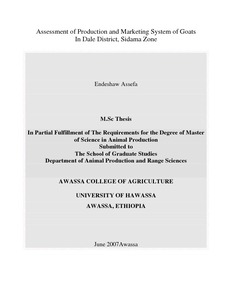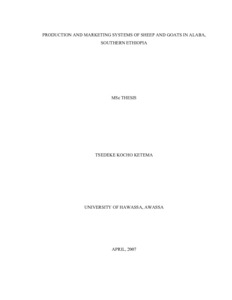Location
Hawassa university is a public university in Ethiopia.
Hawassa University (or HU) was established at Hawassa in April 2000. Since 1976 the colleges of HU had been operational starting with the College of Agriculture. The university was formed by merging three colleges in southern Ethiopia: Awassa College of Agriculture, Wondogenet College of Forestry and Dilla College of Teacher Education and Health Sciences.
Source: Wikipedia (consulted d.d. October 12th 2017)
Members:
Resources
Displaying 21 - 24 of 24Effect of grazing land exclosure and feeding strategy on livestock water productivity in Lencha Dima Watershed, Guba Lafto Woreda, Amhara Region
The study aims to estimate the livestock water productivity (LWP) and to examine the effect of grazing area closure and feeding strategies on LWP at farm household level under wealth and intervention categories at Lencha Dima watershed. Results are based on survey of 120 sample households and focus group discussion. Beneficial outputs of livestock and depleted water for producing them were estimated then livestock water productivity as the ratio of the beneficial out puts and depleted water was estimated.
Assessment of production and marketing system of goats in Dale District, Sidama Zone
Production system and marketing study was undertaken using on 120 sample households to identify and describing goat production systems, to determine production potentials, opportunities and challenges of goat’s production and to describe marketing systems. Three The households were drawn from different location and represented three agro-ecologies; Moist Weyina Dega, Dega and Moist Kola.
Characterization of cattle milk and meat production, processing and marketing system in Metema District, Ethiopia
A study on characterization of cattle milk and meat production, processing and marketing system was conducted in Metema district based on data collected between September and October, 2006. A multistage sampling procedure was employed to select representative kebles and households from CBFS, SBFS and Gendawuha town. A total of 270 households were randomly selected using systematic random sampling method.
Production and marketing systems of sheep and goats in Alaba, Southern Ethiopia
This study has undertaken to describe the sheep and goat production and marketing systems and identify constraints to and improvement options for smallholder farms of Alaba, southern Ethiopia. Results are based on survey of 150 sample households and rapid appraisal of major sheep and goat markets. Flock distribution and holdings in different parts of the woreda vary and thus the study sites were stratified into mixed sheep-goat flock, goat dominating and sheep dominating sites. Average family size of the study area was 6.7. Literacy of household heads accounts 30%.





